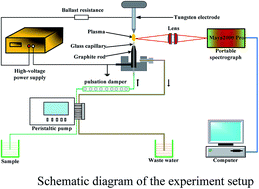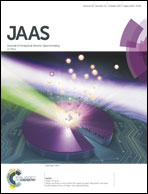Analysis of metal elements by solution cathode glow discharge-atomic emission spectrometry with a modified pulsation damper
Abstract
Solution-cathode glow discharge-atomic emission spectrometry (SCGD-AES) with a portable spectrometer was used to detect metal elements in solution. A modified pulsation damper was designed and optimized to improve discharge plasma stability. The effects of pulsation damper parameters as well as the discharge current and solution flow rate were investigated. The plasma stability of Na, K and Li elements under optimized parameters with the modified pulsation damper was discussed and they showed good stability over a long time. The standard deviation (SD) of background intensity was low, and the detection limits for Zn, Mg, Ag, Pb, Sr, Na, Li, K, Rb and Cs were 72, 2.1, 1.2, 35, 86, 0.04, 0.16, 0.14, 0.38 and 1.1 μg L−1, respectively. Ag, Zn and Pb elements in a certified reference material were quantitatively analyzed, and the measurement results obtained by SCGD-AES agreed well with the reference values. Specifically, the precision (relative standard deviation of 10 measured values) of detection was lower than 1.85%. The results show that the SCGD-AES system with the modified pulsation damper can accurately and stably detect the content of metal elements in water.



 Please wait while we load your content...
Please wait while we load your content...